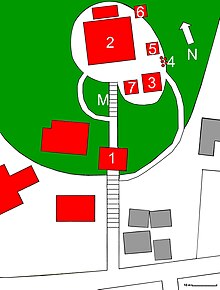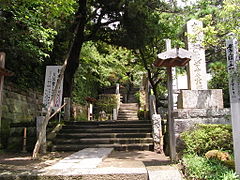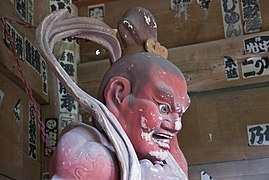Sugimoto-dera
The Sugimoto-dera ( Japanese 杉 本寺 ) with the mountain names Ōkura-zan ( 大 蔵 山 ) is a temple that belongs to the Tendai direction of Buddhism. It is located in Kamakura in Kanagawa Prefecture , Japan. In the traditional count it is the 1st of the 33 temples in the Kantō region .
history
According to the tradition of the temple this was built by order of the emperor Kōmei of Fujiwara no Fusasaki ( 藤原 房 前 ; 681-727) and priest Gyōki in the year Tempyō 6 (734) and is thus the oldest temple in Kamakura. Later it was brought back to bloom by Priest Ennin .
When the Kannon Hall on the nearby Ōkurayama caught fire in 1189 , priest Jōdai-bō ( 浄 台 坊 ) is said to have thrown himself into the flames and saved the three Kannon, wrapped in a cloak. Many believers therefore worship the Kannon, who for their part are now saviors in the sea of flames. Since the Kannon escaped the fire at the foot of a Sugi tree , they were called "Sugimoto-Kannon".
When approaching the temple on horseback, it was customary to dismount in good time. So the Kannon got the nickname Geba Kannon ( 下馬 観 音 ), something like "Kannon off the horse". When priest Lanxi Daolong , founder of Kenchō-ji , came to the temple to pray, wrapped in his stole ( 袈裟 kesa ), the custom of sitting down disappeared. And so the Kannon Fukumen Kannon ( 覆 面 観 音 ), something like "Veiling Kannon" were called.
The attachment
You climb a little up the stairs to the temple complex and come to the temple gate, which is designed here as a Niō gate ( 仁王 門 , Niō-mon; 1 in the plan), i.e. as a gate with the two temple guards ( Niō ) to the right and left of the passage. The steep staircase that provides direct access is closed due to its fragility. It bears the name "moss stairs" ( 苔 の 階段 Koke no kaidan ; M). On the side path at the top, you can see the thatched main hall ( 本 堂 Hondō ; 2). In front of it on the right side there is the small Benten- do ( 弁 天堂 ; 7) and the bell tower ( 鐘楼Shōrō ; 3) , consecrated to the holy Benzaiten .
Further to the right on the edge is a group of stone pagodas ( 五 輪 塔 Gorintō ; 4). Behind it you can see a small shelter for a row of holy Jizō (5) and even further behind the small Gongen Hall ( 権 現 堂 Gongen-dō ; 6).
Temple treasures
In the main hall are the three sculptures of the eleven-faced Kannon .
- In the west of the inner area ( 内 陣 Naijin ) of the main hall, the main cult figure is a Kannon from the late Heian period . Legend has it that when Gyōki was walking through the Kantō area and looking at Kamakura from Mount Ōkura-yama ( 大 蔵 山 ), he said, "This is the right place to worship a Kannon Bosatsu ( 観 音 菩薩 )." is said to have carved a life-size Kannon. It is registered as an important cultural asset of the city.
- Ennin is said to have thought of Emperor Montoku in this temple in 851 and made a Kannon from a tree trunk floating on the sea. This Kannon in the center is as important cultural property registered
- The Kannon in the east of the inner area is also registered as an important cultural asset of Japan. It comes from the middle Kamakura period . On the orders of the Emperor Kazan , Priest Genshin ( 源 信 ; 942-1017) made a Kannon in 985 in which St. Kumano ( 熊 野 権 現 Kumano Gongen ) reveals himself .
photos
Remarks
- ↑ On Google Earth from 2019 you can see that the main hall has got a large protective roof.
literature
- Kanagawa-ken kotogakko Kyoka kenkyukai shakaika bukai rekishi bunkakai (Ed.): Sugimoto-dera . In: Kanagawa-ken no rekishi sampo (ge). Yamakawa Shuppan, 2005. ISBN 978-4-634-24814-4 . Pp. 45, 46.
Web links
Coordinates: 35 ° 19 ′ 21.3 " N , 139 ° 34 ′ 2.8" E






